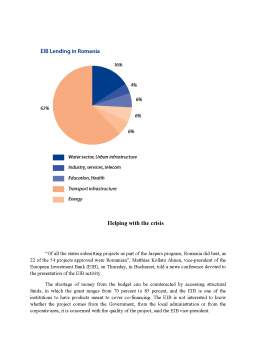Extras din proiect
Introduction
The European Investment Bank is the European Union's long-term lending institution established in 1958 under the Treaty of Rome. A policy-driven bank, the EIB supports the EU’s priority objectives, especially European integration and the development of economically weak regions.
Its shareholders are the 27 Member States of the Union, which have jointly subscribed its capital. The EIB's Board of Governors is composed of the Finance Ministers of these States.
Outside the EU, the EIB is active in over 150 countries (the pre-accession countries of South-East Europe, the Mediterranean partner countries, the African, Caribbean and Pacific countries, Asia and Latin America, and Russia and other neighbours to the East), working to implement the financial pillar of EU external cooperation and development policies (private sector development, infrastructure development, security of energy supply, and environmental sustainability).
EIB Group
The EIB Group consists of the European Investment Bank and the European Investment Fund (EIF). The EIB is owned by the EU Member States. The EIF has several shareholders, the EIB being the majority shareholder:
- EIB: 66%
- European Commission: 25%
- Other European Financing Institutions: 9%
The principal area of cooperation between the EIB and the EIF is in support of small and medium-sized enterprises (SMEs). Their relationship encourages a productive sharing of expertise in support of SMEs.
The EIB provides long term loans to large capital investment projects. In addition, the Bank promotes SMEs through:
- Medium and long-term credit lines to intermediaries in the banking sector
- Venture capital activities in FEMIP and ACP
The EIF concentrates on:
- Investment in innovative SMEs in the EU and Enlargement area though venture capital funds
- SME guarantee operations involving own resources or those of the EU budget
OBJECTIVES of EIB
Within the EU the EIB has 6 priority objectives for its lending activity which are set out in the Bank’s business plan, the Operational Strategy (OS).
- Cohesion and Convergence
- Support for small and medium-sized enterprises (SMEs)
- Environmental sustainability
- Implementation of the Innovation 2010 Initiative (i2i)
- Development of Trans-European Networks of transport and energy (TENs)
- Sustainable, competitive and secure energy
The OS is approved by the Board of Directors and defines medium-term policy and operational priorities for objectives given to the Bank by its Governors. It is also an instrument evaluating the EIB's activities. This rolling plan spans three years, with the strategic projections adapted annually to take account of new mandates and changes in the economic climate.
ORGANIZATION of EIB
The EIB is governed by the:
- Board of Governors - usually the Finance Ministers of the Member States
- Board of Directors - 28 members representing each Member State and the European Commission. There are 16 Alternates, meaning that some of these positions will be shared by groupings of States. The Board also has the right to co-opt a maximum of 6 experts (3 Directors and 3 Alternates), who will participate in the Board meetings in an advisory capacity, without voting rights.
- Management Committee - the President of the EIB and 8 Vice Presidents
- Audit Committee - 3 members and 3 observers appointed by the Board of Governors
The Board of Governors comprises Ministers designated by each of the 27 Member States, usually Finance Ministers. It lays down credit policy guidelines, approves the annual accounts and balance sheet, and decides on the Bank’s participation in financing operations outside the European Union as well as on capital increases. It also appoints the members of the Board of Directors, the Management Committee and the Audit Committee.
The Board of Directors has sole power to take decisions in respect of loans, guarantees and borrowings. As well as seeing that the Bank is properly run, it ensures that the Bank is managed in keeping with the provisions of the Treaty and the Statute and with the general directives laid down by the Governors. Its members are appointed by the Governors for a renewable period of five years following nomination by the Member States and are responsible solely to the Bank.
The Board of Directors consists of 28 Directors, with one Director nominated by each Member State and one by the European Commission. There are 18 Alternates, meaning that some of these positions will be shared by groupings of States.
Furthermore, in order to broaden the Board of Directors’ professional expertise in certain fields, the Board is able to co-opt a maximum of six experts (three Directors and three Alternates), who participate in the Boardmeetings in an advisory capacity, without voting rights.
Decisions are taken by a majority consisting of at least one third of members entitled to vote and representing at least 50% of the subscribed capital.
The President of the Management Committee or, in his absence, one of the Vice-Presidents, shall preside over meetings of the Board of Directors but shall not vote.
As the Board of the Directors is non-resident, members do not receive a remuneration from the Bank. For each meeting day of the Board (normally ten per year) in which they participate Members and Alternates of the Board of Directors receive an indemnity of EUR 600. In addition the Bank pays a per diem of EUR 200 as a lump-sum reimbursement for hotel and related expenses to be covered by individual Board Members and reimburses travel expenses.
The Management Committee is the Bank’s permanent collegiate executive body. It has nine members. Under the authority of the President and the supervision of the Board of Directors, it oversees the day-to-day running of the EIB, prepares decisions for Directors and ensures that these are implemented. The President chairs the meetings of the Management Committee. The members of the Management Committee are responsible solely to the Bank; they are appointed by the Board of Governors, on a proposal from the Board of Directors, for a renewable period of six years.
Preview document
Conținut arhivă zip
- Analysis of European Investment Bank's Activities in Romania.doc
























